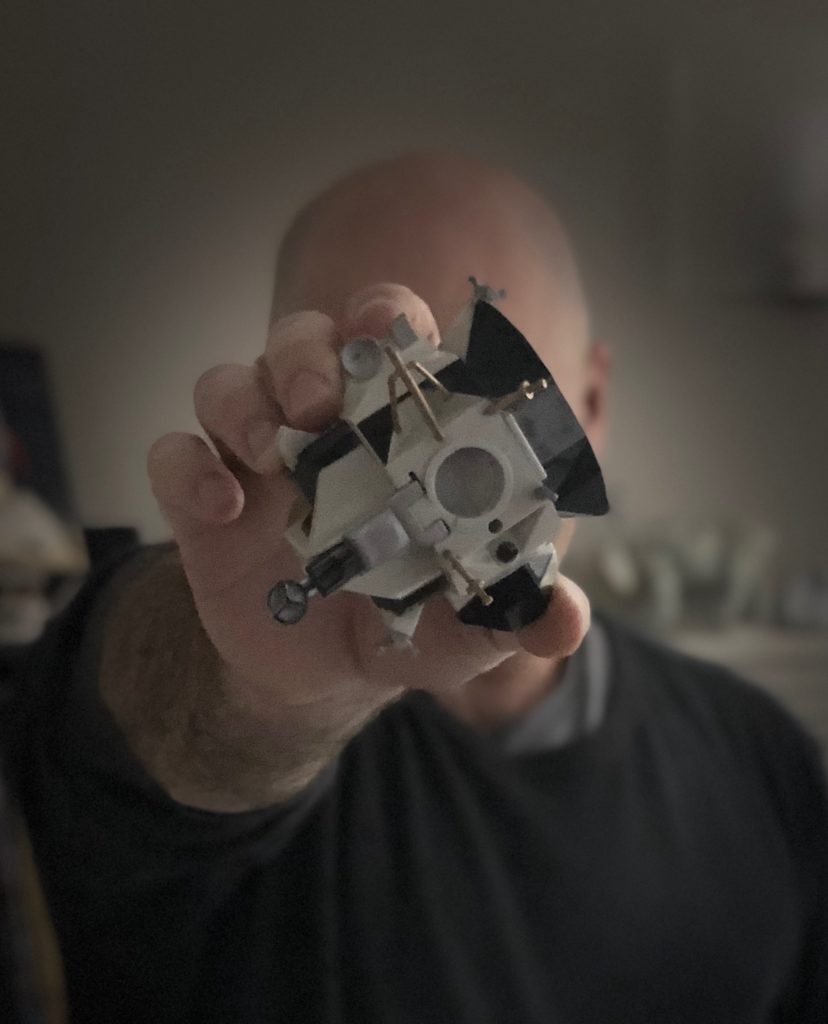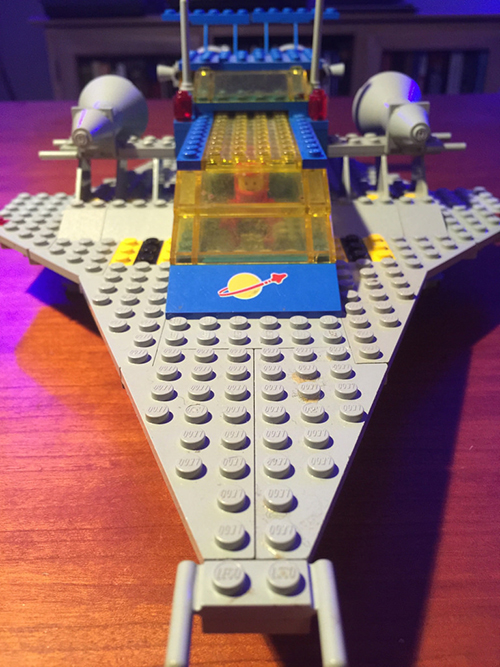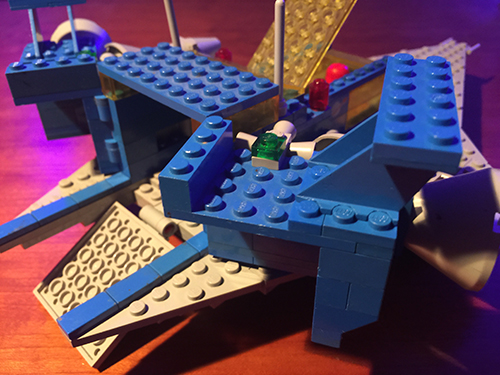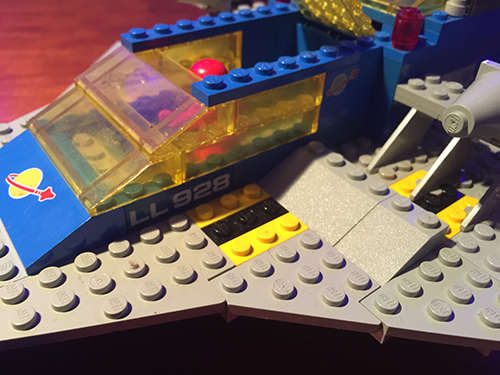Occultation in Texas
My son and I intercepted the total solar eclipse on April 8. It was even more remarkable — larger, darker, spookier — than the only other we’ve seen in Wyoming in 2017.
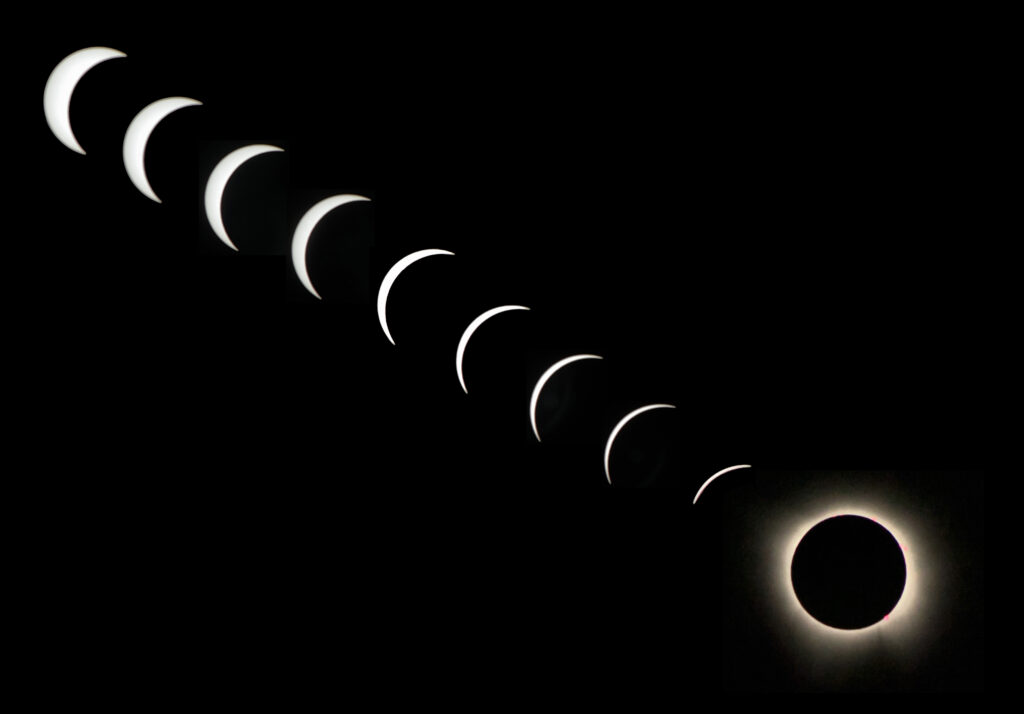
We were relatively unprepared for the one seven years ago (eye protection, yes; ways to capture the experience, not really). But since then — and with the help of an annular eclipse dry run last October — we were ready this time. We knew we wanted to be as near the centerline as possible but with the ability to call a cloud cover audible if needed.
On the morning of the eclipse we headed south from Fort Worth, Texas to a small town called Hillsboro (excuse me, Eclipseboro) but upon arrival determined the clouds were too risky. So we motored northwest, giving up about a minute of totality for what we hoped were clearer skies. Destination: Glen Rose. We found a public park on a branch of the Paluxy River right in town and set up shop.
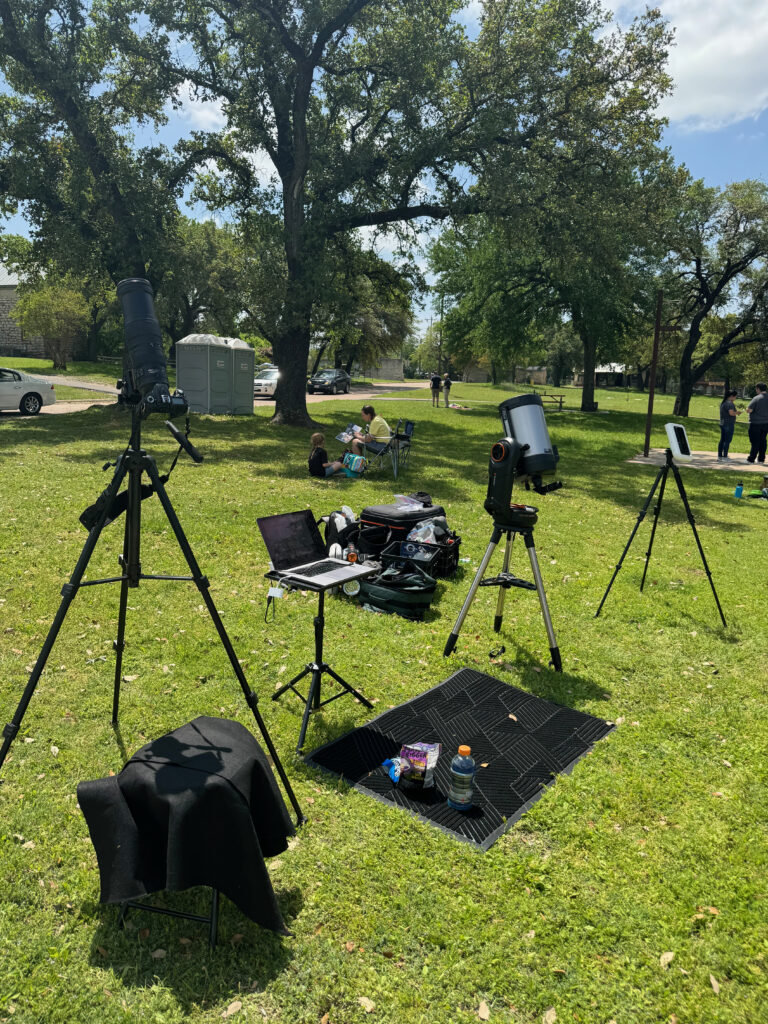
We had three viewing rigs:
- Nikon D90 dSLR + Nikkor zoom lens (AF-S 200-500mm f/5.6E ED VR) + Haida solar filter. This was controlled via USB connected to a MacBook running AstroDSLR, mostly to relieve the tedium and distraction of snapping lots of photos during totality but also to avoid slightly jiggling the rig with a button press on the camera body.
- Celestron NexStar Evolution 8″ telescope + solar filter. I never did turn tracking on as the sun was fairly easy to spot. I probably should have enabled it though. (Next time!)
- The new Vaonis Hestia mount for iPhone. This small white box held the phone in place over its magnifying ocular (with solar filter) allowing photography and on-device processing in real time. I used an iPhone 15 Pro Max. It captured remarkably good photos, such as the composite above.
Having done this a few times by this point I was looking forward to the mix of normal people just out to have their minds blown (often with small children) and giant astronomy nerds ready to shout “first contact!” and similar at every moment of the event. I suppose there are other types of people who show up for eclipses — astrology zealots, doomsday cultists, daytime-curious vampires — though none did where we watched unfortunately.
The moments approaching totality were especially surreal as the day, which normally darkens from a fixed point on the western horizon, got shimmeringly dark from everywhere at once. Light through leaves and colander holes reminded us that our celestial flashlight was no longer circular. We peered through obsidian glass (supposedly used by ancient Mayans to view eclipses, which they accurately predicted). While the obsidian monocle seemed just as dark/protective as our ISO-certified glasses in hindsight maybe I should have verified that.
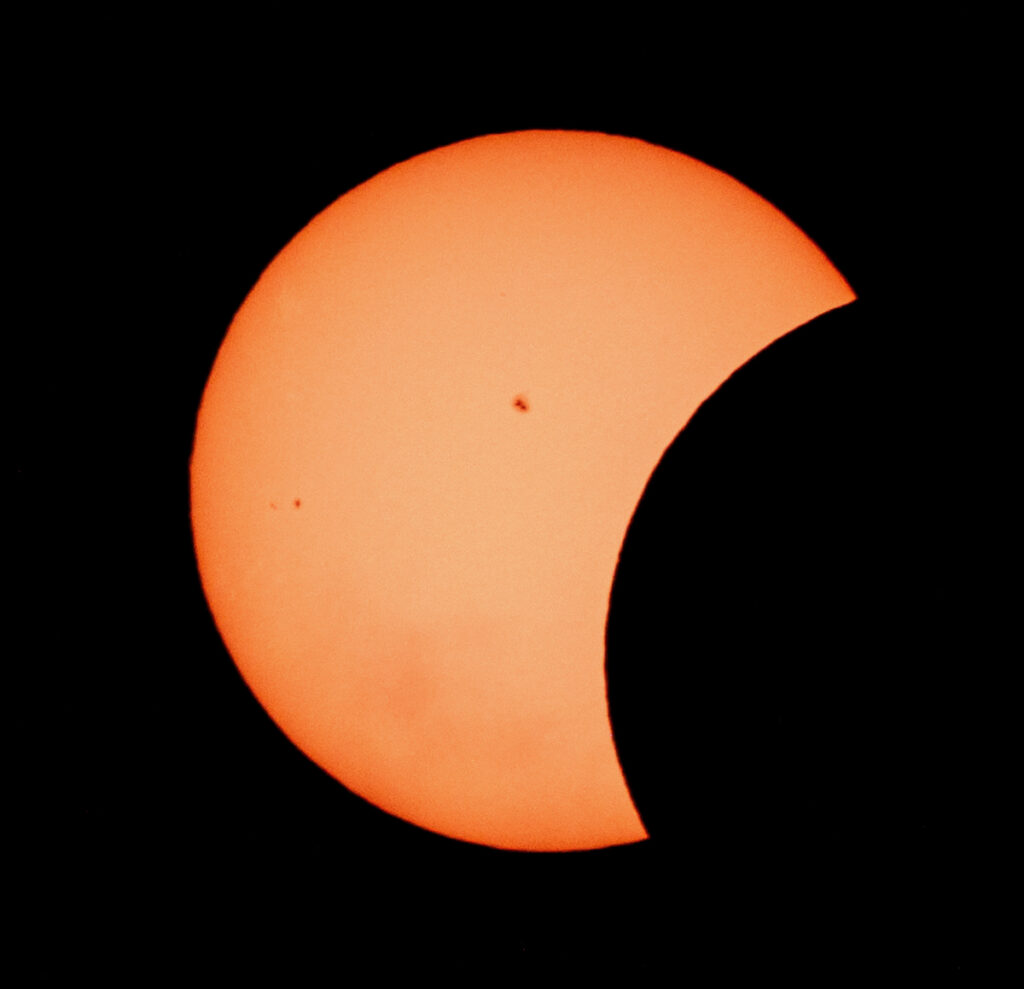
And then it went dark and the protective eyewear finally came off. I’m sure I could look it up to confirm or deny, but it felt like the sun-moon duo was closer in space to us than in 2017 because that scary black hole in the sky looked much bigger. Loopy prominences licked around the edge of the disc while we stared up slack-jawed for both the longest and shortest three minutes and fifteen seconds of our earthbound existence. I couldn’t help but think about how terrifying it all would have seemed for pre-scientific peoples viewing a total solar eclipse. A few minutes of inexplicable darkness and then … right back to normal. (A Navajo friend of mine noted that his people do not view the eclipse as a matter of respect. Tradition holds that it is a time of intimacy between the sun and the moon. Voyeurism is impolite.)
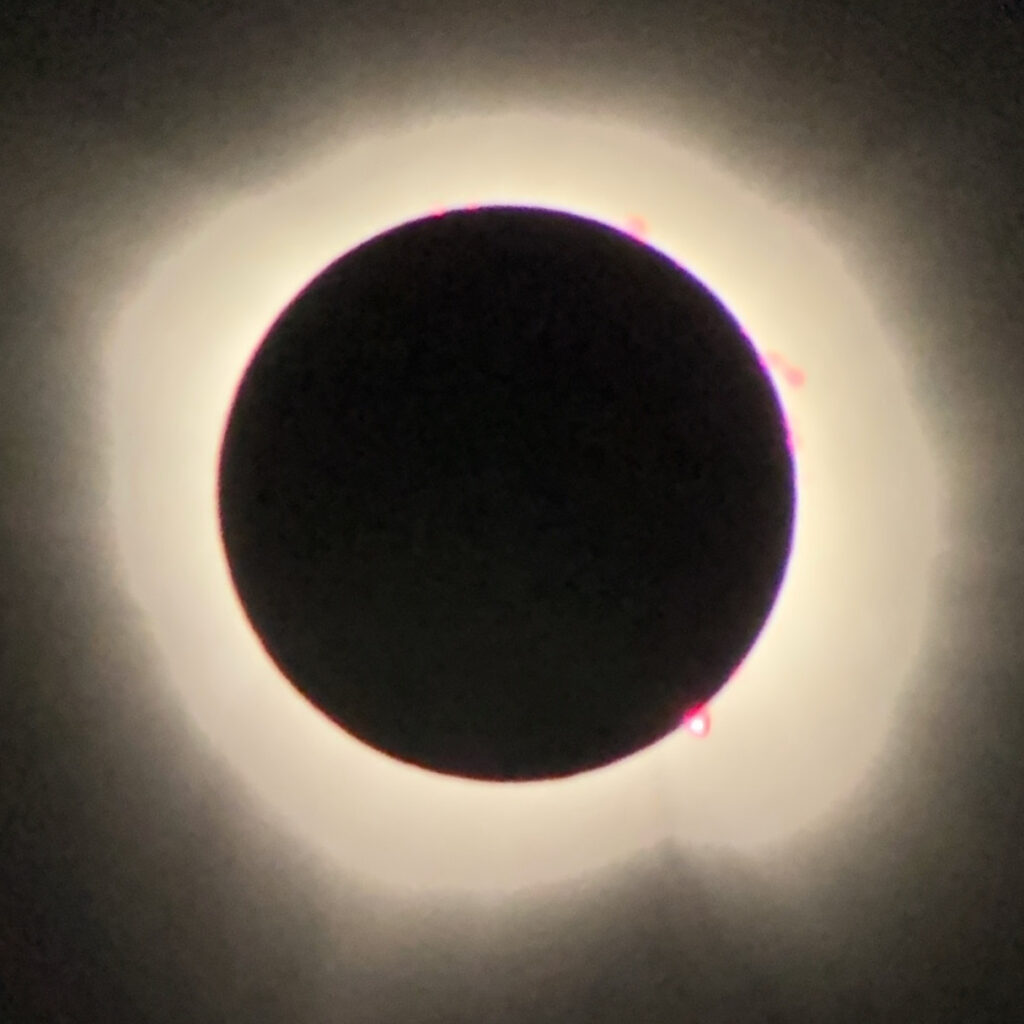
While we were dumbstruck in Texas (and as my other son was preparing for the umbra hurtling away from us and towards him in Vermont at 2,000 MPH) my wife was on an airplane over Ohio. She noticed little crescent-shaped sparkles on the cabin wall next to her window seat. This disco ball effect was caused by reflections from the partially-eclipsed sun glinting off her wedding ring! As my wife was the only person in her section who brought eclipse glasses, she eventually had the whole cabin at her seat staring at our moon nudging in front of our star.

On the drive down from Denver I learned quite by chance that helium is so named because its presence was spectroscopically determined during an 1868 eclipse in India. The chance part of my learning this was due to my stopping at the Helium Time Columns Monument time capsule in Amarillo, Texas — former site of our nation’s strategic helium reserve. Even though helium is the second most abundant element in the universe, those dirigibles and zeppelins weren’t gonna inflate (or blow up) themselves. So America stockpiled.
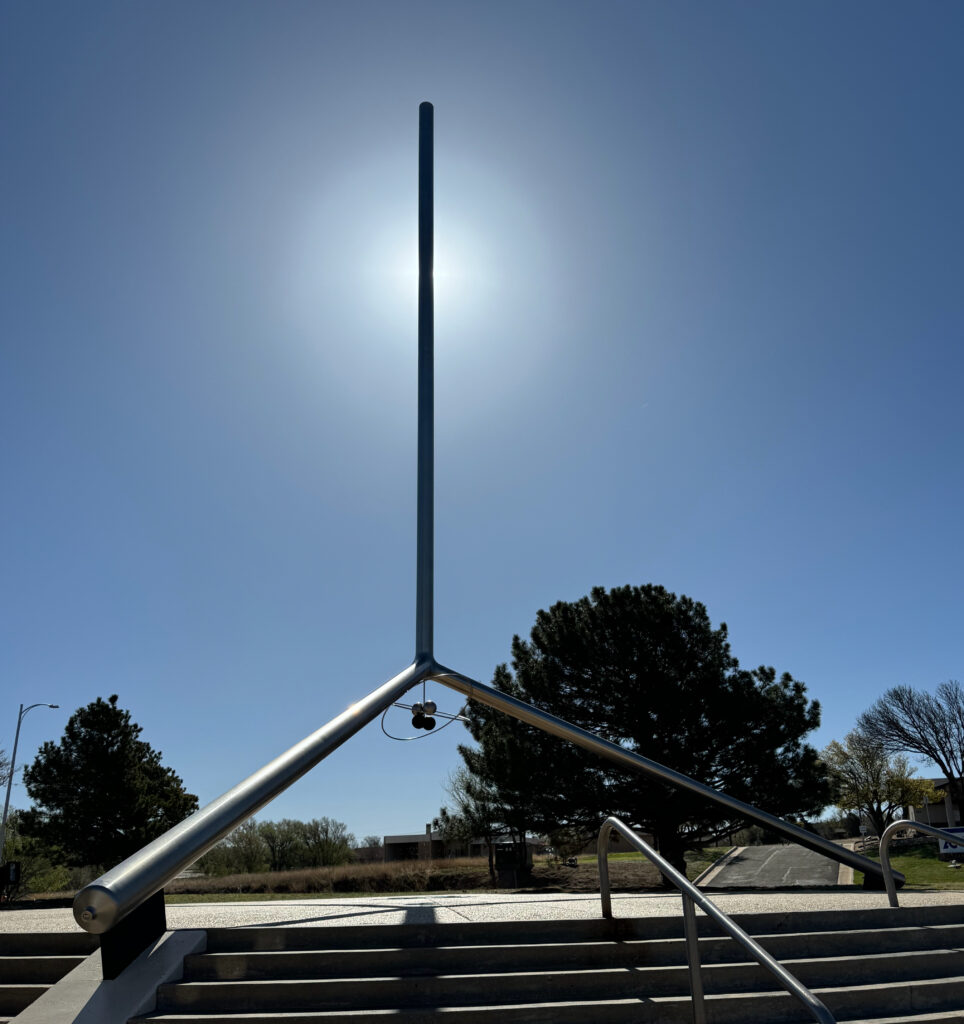
But back to Glen Rose. Other than being in the crosshairs of totality, this pretty little town is the jumping off point for two related points of extreme cognitive dissonance.
The Paluxy River flows right through town and into Dinosaur Valley State Park, where over the last millions of years it has eroded various types of rock to expose Early Cretaceous dinosaur tracks of both sauropods and theropods. The fun thing about these trace fossils is that they exist almost exclusively in the flowing riverbed itself. You gotta wade if you wanna nerd up. Often because of high water the tracks are not visible at all. But on my visit they were on full display. It was rainy and wet (obviously) which gave the expedition as slight air of danger but the park is well-signposted and easily accessible. Plus, with water continuing to erode the riverbed, this priceless evidence of dinosaur behavior is slowly being erased. Catch them while you can. (Or go see this entire section that was lifted out and sent to the American Museum of Natural History in NYC.)
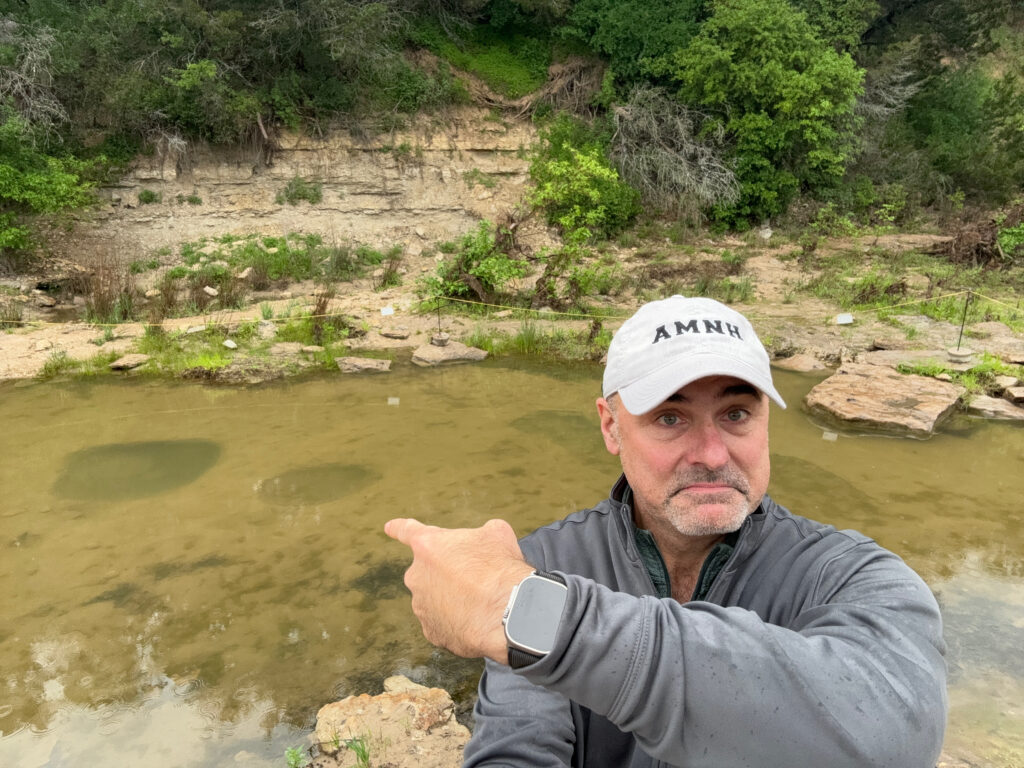
But scientific artifacts are not the only thing this river has gurgled up. Glen Rose is also home to the Creation Evidence Museum where tracks lifted from the Paluxy are purported to prove that humans lived side-by-side with dinosaurs, Flintstones-style, which of course thus proves biblical creationism, an earth only 6000 years old, and other utter fictions. The contortions this museum wriggles itself into to prove that the fossil record synchs with the bible are comical: mapping geological epochs to precise days of biblical flood, building a model of an ark complete with holding zones for Tyrannosaurus rex (seems unwise, Noah), and a giant hyperbaric chamber meant to recreate conditions for bringing non-avian dinosaurs back to life. What.
The centerpiece of the museum are tracks that show impressions of human footprints next to or overlaid on dinosaur tracks. Most of the footprints are deliberate fakes created to sell during the Great Depression but the urge to validate an already-held belief can be powerful and sometimes you build an entire fantasyland around that. Of course, there’s margin for error in all paleontological and geological time estimates but being off by 100 million years is, you know, well outside that margin. We actually find evidence of ancient peoples next to dinosaur tracks all the time. They were as fascinated by fossils as modern humans are, but that doesn’t mean that humans rode Velociraptors bare-back.
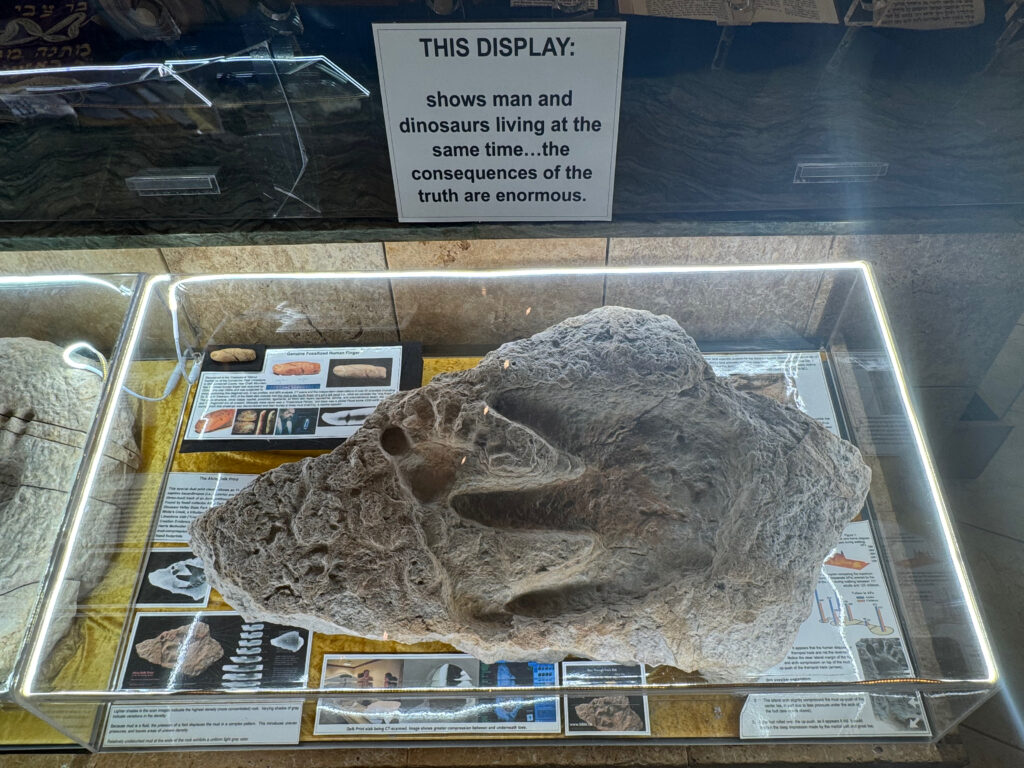
It was difficult to maintain a straight face in this place, I admit. The cartoonishly white-coated and goggled “scientists” running around a lab full of seemingly legit equipment (what exactly were they testing?); the bus full of home-schooled kids, grist for the generational conspiracy theorist pipeline; the non sequitur side exhibit on the moon landing (presented as real, not a conspiracy — possibly meant to allay fears that the curators are complete crackpots). An entire universe of fallacy meant to make people feel good about not questioning their faith.
We don’t still believe eclipses are a dragon eating the sun, or celestial gods at war, or even a moment of intimacy (the Navajo offer this respect out of cultural tradition). Science advances because we constantly question it. It’s how we discover helium. It’s how we verify Einstein’s General Theory of Relativity. It’s how we know exactly where to stand in a beautiful little town in Texas to view a rare astronomical event. So, thank you, science. And thank you Creation Evidence Museum, for the concise if troubling example of what happens when you want to be comfortable in belief rather than disquieted by truth. Go see the next total solar eclipse, friends. (Or better yet, go see the 2027 eclipse over the pyramids of Egypt!).

Itinerary footnote: this journey included a few other stops related to dinosaurs and crazy right-wingers: An easy hike to the KT boundary in Trinidad Lake State Park (lots of shocked quartz layers from the meteor impact that ended the reign of the dinosaurs 66 million years ago); the excellent dinosaur trackways of Clayton Lake State Park in New Mexico, where tracks became visible when a reservoir spillway was constructed decades ago; and Bishop Castle, the monomaniacal building project of a father-son duo in rural Colorado that is what happens when someone really loves the garden gnome aesthetic and spatial logic of M.C. Escher while also hating workplace safety and all forms of government.
Spaceship! Spaceship! Spaceship!
A few notes on rebuilding my first LEGO set from 1979.
I set out to build the iconic, genre-defining LEGO Galaxy Explorer. I knew I had the original pieces as I have every brick I was ever given, bought, or bought for my own kids. There are tens of thousands of pieces in several bins full of 35 years of detritus that inadvertantly got mixed into the slurry. Batteries from the 1980’s (long since having leaked their acid), various mementos, trash, thumbtacks, model pieces, indecipherable bits of toys and games, sharp shards of pieces long since stepped-on and cracked. Finding the original bricks was part autobiographical archaeology, part that Russian Roulette scene with the log creature in Flash Gordon.
The LEGO Galaxy Explorer jumpstarted the “Classic” phase of space-themed brick sets. Before dueling factions, before space police, before aliens and whatever the hell Bionicle was, Classic Space was about exploration, period. It’s interesting to read the set as a kind of cultural document for the vision (perhaps a Danish vision) of what spaceflight was or could be in the late 70’s.
Apollo was over. Skylab had just plummeted back to Earth. Salyut 6 still orbited. And the Space Shuttle was in testing for its maiden voyage. Clearly the shuttle was an influence on the Galaxy Explorer: both have fixed wings and separate crew and cargo compartments. But exploring the design of the brick ship suggests that the new NASA orbiter was not its only inspiration.
The Galaxy Explorer is the threesome lovechild of a Space Shuttle, a dump truck and a Harrier jet. How else would you explain the loading ramp in the back which really only works in gravity where you can cart things up? Or that, without wheels, the ship clearly does not take off like a plane. The underside engines are obviously for vertical ascent. And if you got those, why do you need wings at all?
The answer is what makes LEGO such an incredible company: the design of the ship is as influenced by how human beings play with interlocking bricks as it is by actual spaceships. It’s the difference between LEGO and model kits. For one, kids play with LEGO bricks in an environment with gravity. They might fly the ship in their hand through the air, but actually interacting with it takes place on some surface, orbital mechanics be damned. This explains the loading ramp (kid drives LEGO car around on a surface and into the ship) and the vertical take off (kid grabs the ship and yanks it up), and even the wings (that’s how the kid holds it). It’s a very planet-based (or at least surface-based) view of space travel, because that’s how (and where) kids play.
Play as primary design driver is evident in an odd little locking piece that keeps the cargo bay doors from flying open. It is one of the rare instances I know of where a piece is added simply for convenience of real-world usage. The 1×2 flat blue piece has no aesthetic or functional value on the ship-as-ship, only for ship-as-plaything. Take that, fourth wall!

Then there’s the ornamental, gaudy and inexplicable: racing stripes (huh?), logos, vents, fuselage arrows (for ground crews?) and livery numbers. No decals, thankfully. The whole thing was driven by an actual circular steering wheel (something even airplanes don’t use). Maybe the ship never did leave the ground: the minifigs have visor-less helmets and zero protection from the (lack of) elements other than their spacesuits.
It’s the color scheme, though, that defines Classic Space for me. Gray base plates and horizontal surfaces, blue structural elements, translucent yellow windows. Toss in a few computer bricks (oh, the computer brick!), a radar dish, and some green and red see-through 1×3 cylinders — that aesthetic shaped my LEGO creations for the better part of a decade. (Green? There is no green in space.)
But there is yellow. As in yellowing pieces. Though I was fastidious in making sure I found ever single correct piece — never substituting or otherwise being clever — I obviously did not find all the original pieces. The slight yellowing (and relative state of cruft accumulation) on some of the bricks is a dead giveaway. I bet 30% of the ship is original. I kinda like it actually. The original Star Wars showed us how cool beaten-up, dusty and old space could be. My LEGO Galaxy Explorer wears the patina of time well.
If you’ve seen The LEGO Movie you have witnessed the legacy of the Explorer. The character Benny maniacally flies around yelling “Spaceship! Spaceship! Spaceship!” in a craft that is clearly inspired by the original set. It’s over-the-top, but retains the rough geometry, retro rockets, racing strips, and (maybe) the cargo bay. In a nod to dorks like me in the film, the actual spacesuited character is cracked and clearly worn through time.
Sometimes the future is nostalgia.
Lost in Space, Ascent Stage edition
Got the urge to muck with the Lost in Space theme recently. I loved the re-runs of that show growing up (and have deliberately forgotten that a movie was made of it in the 90’s). The theme I used began with the show’s third season.
The title track is tiny, just one minute long with an unfortunate or awesome (your pick) Austin Powers breakdown in the middle, so there wasn’t much to work with. The arpeggios are emblematically spacey to me so I ran with that. I replaced The Robot with Siri, the panicky AI of our time (especially when using Apple Maps).
I really should embed this on this site’s 404 page.
Geeks with a project
If you spend any time on the web you know that today is the 40th anniversary of Apollo 11’s moon landing and the first steps of humans on the lunar surface. There’s been some great coverage from We Choose The Moon, to the live Twitter feed “replay”, to Kottke’s (now-finished) real-time TV coverage playback, to the Google graphic that actually has changed to follow the progression of the landing (and earthrise)!
The commemoration has caused me to reflect personally on the impact of the moon landing. Despite what you may have heard, the name of this blog references the upper half of the lunar lander, the stage that ascends to rendezvous with the command module for the journey home. My choice of that term came from a period of my life of intense interest in spaceflight* partially because of the sheer thrill of it, partially because of the series From The Earth To The Moon, but mostly because, at the time, I was a young project manager in a massive organization who saw in the moonshots the attempt to do something amazing with lots of smart people, cutting-edge technology, and a common goal. I didn’t want to be Neil Armstrong so much as Gene Kranz.
In the tributes, you’re not hearing a lot about the thousands of private contractors who helped plop the 12 guys on the moon. But the organization of that many people to do something of that magnitude in just a little more than 7 years may be as remarkable as the outcome.
IBM, the company that I work for, was a large part of this effort and I admit that this is a source of pride for me. I’ve had this photo of mission control taped to my cube for as long as I can remember.
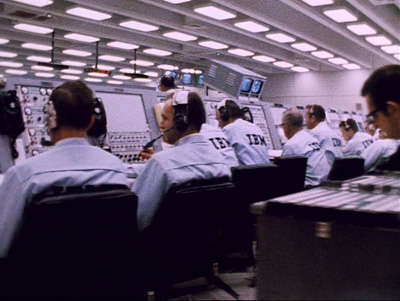
These are my people. Practitioners of a timeless nerdiness that I think of often when I confront organizational bureaucracy or technical hurdles in my own job — one which ain’t, after all, rocket science. IBM has a great subsite up on our contribution to the space race.
Closer to home, I have the memory of my wife’s grandfather, William Boulet, who went to work as an engineer for Boeing after leaving the Army Air Corps after WWII (where he survived a year as a Nazi prisoner). At Boeing Grandpa Boulet designed a particular bolt that was used inside the fuselage of the Saturn V rocket and for his service he was given a commemorative medal — a keepsake I was given by his family when he passed away in 2005. I grabbed it before I left for work today. Not exactly sure why, but I felt like having it with me.
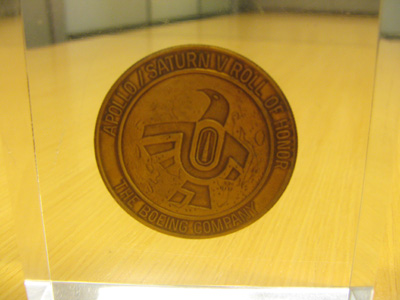
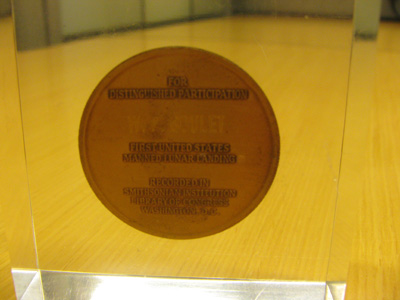
It isn’t nostalgia, of course, for I was not alive for any but the very last landing — and only a newborn then. For me, the Apollo program is equal parts inspirational and aspirational. Whether you agree with the purely political motives that set us on the course to the moon or not, my feeling is that what the effort itself represents is the very best of what humans can do when given a massive challenge packaged in a disheveled box of constraint.
We certainly have freighters full of that particular parcel today. Let’s get unwrapping.
* An interest, it should be noted, that has not so much waned as been tempered by the seeming lack of grand purpose that NASA has fallen into as an orbital trucking company.
Space opera
Lots of things happening heavenward today.
An astronaut whose mother was killed by a train while he was on the International Space Station for 120 days will return to Earth on the Shuttle.
The US Navy will attempt to hit a satellite moving at 22,783 MPH with a warhead-less missile launched from a ship in the Pacific. (Note to military: ever considered a self-destruct button on our spy sats? Or just telling the world we’re testing a new weapons plaftorm? That would work too.)
A total lunar eclipse will occur at 10:01 PM ET tonight.
All of you on the good Earth
Apollo 8: December 24, 1968
A game that would displease the range safety officer
OK, so here’s an inspired idea, the kind of thing devised by idiots who’ve been drinking all weekend.

You know the game called 500? Basically you throw a tennis ball into the air. Players then run under it, pushing, shoving, and perhaps groping for the ball as it comes down. You get 100 points for catching it on the fly, 75 for one bounce, 50 for two, etc. If you touch it on the fly and drop it you lose 100 points, with negative points for touching the ball mirroring the gains for catching it. (At least that’s how I grew up playing it.)
So this weekend. My college friends and I were gathered for our annual Fall session of telling stories like none of us had ever heard them before and being demonstratively juvenile. We discovered that the house we were staying in contained a model rocket and loads of propellant. Of course we had to shoot it off.
I had not done this since I was little. I was soon reminded that the key to the whole thing (or rather the key to doing it more than once) is the secondary charge that goes off to spring the nose cone and deploy the parachute which floats the whole fuselage* back to Earth.
We were doing in this in the middle of a prairie. It wasn’t exactly parched, but I’m not sure Smokey the Bear (or NASA or the FAA) would have approved. As soon as the first one went up a small group of the inebriated ran out into the field, matching — or attempting to match — the trajectory of the descent with their own jagged strides. Just like 500, you see. But the problem was that it was dusk and the rocket went way the hell up. At it’s apogee (yay, SAT!) it was lost from human eyesight. Only a few hundred yards up did it become visible and usually it was hurtling down with a half-opened, if not outright flaming, parachute. Dangerous as all hell. If you’re not pegged in the face with a rocket strut you’re scalded by the hot cylinder itself. It was pure comedy.
Try it sometime and remember where the game was invented, right here on Ascent Stage. For added difficulty play in an urban area with lots of obstacles.
[*] A descent stage, you might say. But you would be wrong. A descent stage is a powered rocket whose purpose is to counteract gravity during a descent (as in to the moon). But that’s a great idea. Where are the model rockets with descent stages!?
Project wisdom from the old NASA
“If a major project is truly innovative, you cannot possibly know its exact cost and its exact schedule at the beginning. And if in fact you do know the exact cost and the exact schedule, chances are that the technology is obsolete.”
— Joseph G. Gavin, Jr., discussing the design of the lunar module* that landed NASA astronauts on the moon.
Yeah, boss. That’s why we’re late and over budget. You don’t want to be obsolete, do you?
[*] The upper half of which is called, ahem, an ascent stage. We’re all about inspirations to innovation around here.
Via SvN.
Caputo’s career kaput
Looks like my shout-out last year to the world’s first female Italian-American in orbit will be my last for her. The press just loves the story of Lisa Caputo Nowak’s alleged melting-down over a love triangle — as though astronauts aren’t human. She’s an Italiana, fercrissakes! Of course she’s fiery!
I think it’s fair to say that she’s not going to pass the next pre-flight psych check. My guess.
If you’re catty in space, can anyone hear you growl?
UPDATE: And the whole fascination with wearing diapers for the long drive. C’mon, how do you think they spacewalk for 8 hours? She’s just used to efficiency.

